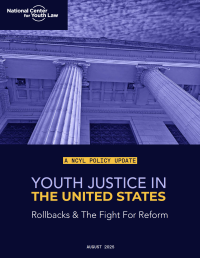The Aftermath Of Miller V. Alabama
Hope For Those Sentenced To Life Without Possibility Of Parole For Juvenile Crimes
The tide has turned with respect to life sentences for crimes committed by youth under the age of 18. The U.S. Supreme Court has declared that mandatory life sentences without a possibility of parole for such youth are unconstitutional. Some states, such as California, have almost entirely eliminated life without possibility of parole as a sentencing option for youth.1 Examples of how these changes will play out for those who were sentenced under the prior regime are few, but growing in recent months.
Seeking Resentencing in the Wake of Miller v. Alabama: Adolfo Davis
In the 2012 case Miller v. Alabama, the U.S. Supreme Court recognized adolescents’ “diminished culpability and heightened capacity for change”2 and ruled that mandatory life sentences without the possibility of parole for those who committed their crimes before the age of 18 are unconstitutional.3 But the Miller decision left open the question of whether it would apply to the individuals with final mandatory life sentences for crimes committed before the age of 18. Advocates are now making their case in court that it should. In about 10 states thus far, inmates have petitioned courts for resentencing, with mixed results.4
One recent successful case involves Adolfo Davis, now 37, who has served well over half his life for a crime he was a part of in the eighth grade, at age 14. He took part in a robbery in which two men were killed. Though he wielded a gun, he never fired it. He was convicted as an accomplice, and sentenced to life without the possibility of parole.5
Davis and four other inmates successfully petitioned an appeals court for resentencing, but the state of Illinois appealed those decisions to the Illinois Supreme Court. In a unanimous decision issued March 20, 2014, the Illinois Supreme Court ruled that the Miller ruling applies retroactively because it is a “new substantive rule.” People v. Davis, 2014 IL 115595, ¶41. The court concluded that Miller is a new substantive rule because it “places a particular class of persons covered by the statute—juveniles—constitutionally beyond the State’s power to punish with a particular category of punishment—mandatory sentences of natural life without parole.” Id., ¶39.
The Illinois Supreme Court heard oral argument on January 15, 2014. Patricia Soung, a former NCYL staff attorney who represented Davis for two years while at NCYL, argued on Davis’s behalf. She explained that the 2012 Miller decision was so significant that it amounted to both a substantive and “watershed” change to the law. As a result, she successfully argued, his mandatory life sentence was invalid and the state is required to reconsider Davis’s sentence in light of all mitigating evidence, including his very young age at the time.6
The facts of Davis’s case are similar to those of many youth who get entangled in serious crimes at a young age: for example, a history of neglect and poverty, membership in a gang for family and a sense of belonging, and the presence of older co-defendants. As reported by the Chicago Tribune, at the time of the murders, “he was living on the South Side with a grandmother who could barely care for him. His father was absent, and his mother was a drug addict. He had no money, so he fed himself by committing petty crimes. He was a scrawny kid who was teased because he often wore the same clothes to school.”7 He also has an inspiring story of turning his life around in prison; renouncing gangs and encouraging young people to do the same, writing poetry, and even getting engaged.
As a practical matter, advocates have pointed out that the premise behind the Miller decision applies equally to juveniles who were convicted before the Miller decision came out. According to Jody Kent Lavy, director and national coordinator of the Campaign for the Fair Sentencing of Youth, research shows that adolescents have less impulse control and “possess a unique capacity for change. These facts apply to all children, including those convicted before the Miller ruling in June 2012.”8
With this recent decision, Illinois joins courts in Texas, Nebraska, Massachusetts, Mississippi, and Iowa that have also ruled that Miller is retroactive. The Nebraska Supreme Court also very recently issued its ruling in the context of three individual cases.
In State v. Mantich9, the court addressed head on whether the Miller decision applied to inmates whose convictions had already been upheld on appeal. The court found that the Miller ruling resulted in a “substantive” change to sentencing law, meaning it does apply to those inmates retroactively. This stands in contrast to some other state supreme courts that have held it is “procedural” rule and thus does not apply retroactively to those with final sentences. As some commentators have noted, the fact that this decision is part of a deep split among state supreme courts makes it prime material for appeal to the United States Supreme Court.10
The defendant in the case, Doug Mantich, now 37, was convicted of a 1993 Omaha carjacking that resulted in the shooting of Henry “Hank” Thompson, 20. He will now return to court to be resentenced under a law passed last year, in the wake of Miller, which allows sentences from 40 years to life for his crime. The law also requires judges to consider factors that could mitigate the youth’s responsibility.11
The two defendants in the other cases, who were convicted for shooting deaths they participated in at ages 15 and 17, also will be resentenced under the new law. The issue in State v. Castaneda12 was Nebraska-specific. The court held that under Nebraska’s sentencing scheme, a life sentence effectively meant life without parole. As such, individuals sentenced under that scheme are subject to Miller. In State v. Ramirez13, the court decided that on remand the new sentencing scheme passed last year will apply. Mantich, Castaneda, and Ramirez are three of 27 inmates serving life sentences in Nebraska for homicides committed when they were younger than 18.14
Retroactive application of Miller is a major victory, but is not the end of the journey for these individual defendants. They will now return to court to receive new sentences after all relevant factors are considered. It is only if they receive shorter sentences that they will directly benefit from these decisions.
Resentencing Following Passage of California’s Fair Sentencing for Youth Act
Some states have gone beyond the minimum of what is required under Miller—to do away with mandatory sentences of life without parole for crimes committed by juveniles—and have barred sentences of life without parole for juvenile crimes altogether.15 In October 2012, California, a state that previously had discretionary life without parole sentencing for youth, passed Senate Bill 9 (SB9). Also known as the “Fair Sentencing for Youth Act,” it eliminates life without possibility of parole sentences for crimes committed by juveniles. Under SB9, certain youth sentenced to life without parole can petition for a sentence review, which, if granted, could lead to a reduced sentence or release.
The first resentencing for a juvenile crime under SB9 was just secured in December 2013.16 Edel Gonzalez is now 38 and has been in custody more than half his life, since 1991. The crime resulting in his life sentence was participation in an attempted carjacking that resulted in a death. Similar to Addolfo Davis, he was convicted of felony murder despite the fact that he did not pull the trigger. In fact, Gonzalez did not even carry a weapon, and had no significant record. Still, he was sentenced to life without the possibility of parole; the youngest individual in Orange County at that time to ever receive such a harsh sentence. Over the next two decades, Gonzalez became a model prisoner—graduating from high school; finding religion; and avoiding gangs, drugs, and violence.17
A formidable team was assembled to test the application of SB9 in Gonzalez’s case. Barry Krisberg, a national expert on juvenile justice issues wrote a declaration stating that Gonzalez was qualified to petition for resentencing under SB9 and no longer represented a threat to public safety.18 Irell & Manella, a Southern California-based firm, took on the case pro bono, assigning four lawyers to the case.19
At his hearing in the Orange County Superior Court, Gonzalez spoke powerfully about his regrets, and his hopes for the future: “There isn’t a day that goes by when I’m not reminded of the wrong, the harm and the pain I’ve caused. If given the opportunity, I hope one day to help young kids stay away from gangs and their lies—kids that think there’s no way out, as I did in my youth. I want to share with those kids my personal experiences of this life.”20 The judge agreed that Gonzalez deserved a second chance, finding his institutional record “exceptional,” noting that he had no reprimands for violence or for drug or alcohol use, which are prevalent in state prison. The court also recognized that Gonzalez was given a risk assessment score of “1” by the California Department of Corrections and Rehabilitation, signifying that he was a low risk for recidivism, and that the California Youth Authority had found him amenable to change in 1997.21
Gonzalez became the first direct beneficiary of SB9 when the court resentenced him to 25 years to life, meaning that he may be eligible for parole in less than three years, as he has already served 22 years behind bars. It is estimated that there are hundreds of prisoners in California alone who received a sentence of life without possibility of parole for crimes committed as juveniles.22 For them, Gonzalez’s case provides at least a glimmer of hope.
Three Cases in Nebraska in the Aftermath of Miller v Alabama
 The Nebraska Supreme Court recently considered three cases directly addressing the relation of Miller to individual cases.
The Nebraska Supreme Court recently considered three cases directly addressing the relation of Miller to individual cases.
In State v. Mantich1, the court addressed head on whether the Miller decision applied to inmates whose convictions had already been upheld on appeal. The court found that the Miller ruling resulted in a “substantive” change to sentencing law, meaning it does apply to those inmates retroactively. This stands in contrast to some other state supreme courts that have held it is a “procedural” rule and thus does not apply retroactively to those with final sentences. As some commentators have noted, the fact that this decision is part of a deep split among state supreme courts makes it prime material for appeal to the United States Supreme Court.2
The defendant in the case, Doug Mantich, now 37, was convicted of a 1993 Omaha carjacking that resulted in the shooting of Henry “Hank” Thompson, 20. He will now return to court to be resentenced under a law passed last year, in the wake of Miller, which allows sentences from 40 years to life for his crime. The law also requires judges to consider factors that could mitigate the youth’s responsibility.3
The two defendants in the other cases, who were convicted for shooting deaths they participated in at ages 15 and 17, also will be resentenced under the new law. The issue in State v. Castaneda4 was Nebraska-specific. The court held that under Nebraska’s sentencing scheme, a life sentence effectively meant life without parole. As such, individuals sentenced under that scheme are subject to Miller. In State v. Ramirez5, the court decided that on remand the new sentencing scheme passed last year will apply. Mantich, Castaneda, and Ramirez are three of 27 inmates serving life sentences in Nebraska for homicides committed when they were younger than 18.6
- No. S-11-301.
- Kent Schiedegger, Juvenile LWOP in Nebraska, Crime and Consequences Blog, Feb. 7, 2014.
- Joe Duggan, Nebraska Supreme Court ruling could affect 27 murder cases, Omaha World-Herald, Feb. 8, 2014.
- No. S-11-023.
- No S-11-486.
- Joe Duggan, Nebraska Supreme Court ruling could affect 27 murder cases, Omaha World-Herald, Feb. 8, 2014.
- Kelly Orians, One Year Later: State Level Response and Implementation of Miller v. Alabama, Youth Law News, Vol. XXXII, No. 3, July-Sept. 2013.
- Echoing its earlier cases Roper v. Simmons (2005) and Graham v. Florida (2010).
- 132 S. Ct. 2455 (2012).
- Kim Geiger, Mandatory life sentences for juveniles at issue before state high court, Chicago Tribune, January 15, 2014.
- Id.
- Kim Geiger, Mandatory life sentences for juveniles at issue before state high court, Chicago Tribune, January 15, 2014.
- Id.
- Id.
- No. S-11-301.
- Kent Schiedegger, Juvenile LWOP in Nebraska, Crime and Consequences Blog, Feb. 7, 2014.
- Joe Duggan, Nebraska Supreme Court ruling could affect 27 murder cases, Omaha World-Herald, Feb. 8, 2014.
- No. S-11-023.
- No S-11-486.
- Joe Duggan, Nebraska Supreme Court ruling could affect 27 murder cases, Omaha World-Herald, Feb. 8, 2014.
- Kelly Orians, One Year Later: State Level Response and Implementation of Miller v. Alabama, Youth Law News, Vol. XXXII, No. 3, July-Sept. 2013.
- First Resentencing Under SB9 for Pro Bono Client, Irell & Manella, Press Release, December 2013, available at: http://www.irell.com/matters-item-43.html
- The facts of Gonzalez’s case in this paragraph are largely taken from a Berkeley Law News Archive article. See Leslie A. Gordon, Alum Wins Resentence for Inmate Under New State Law, Berkeley Law News Archive, January 21, 2014, available at:http://www.law.berkeley.edu/16511.htm
- Id.
- First Resentencing Under SB9 for Pro Bono Client, Irell & Manella, Press Release, December 2013, available at: http://www.irell.com/matters-item-43.html
- Id.
- Id
- Leslie A. Gordon, Alum Wins Resentence for Inmate Under New State Law, Berkeley Law News Archive, January 21, 2014, available at:http://www.law.berkeley.edu/16511.htm





